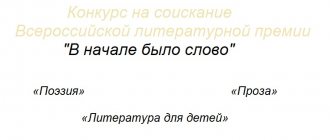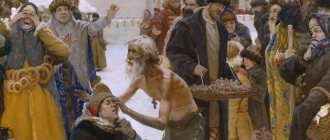There have been many interpretations of the phrase “In the beginning was the Word, and the Word was with God, and the Word was God.” Thus, in the Bible, the Gospel of John describes the birth of life from nothing. But all the explanations and transcripts seemed as mystical and mysterious as the evangelist’s statement itself. But Commissioner Qatar’s understanding of this biblical expression seemed sensible. At the same time, the statement that we are created in the image and likeness of God became more understandable. I now know what kindred spirits are and understand who the revealed soul is.
True, the Commissioner of Qatar himself, as an Old Believer, offers his own version of this famous biblical phrase: “In the beginning there was the Word and the Word was with God and the Word was God.” But this does not affect the essence of the issue. Although “In the Origin” is not quite “In the Beginning”. But the conversation now is about something else.
I will operate in the text with the usual form of this expression from the Bible: “In the beginning was the Word, and the Word was with God, and the Word was God.” I came across a statement that it was translated incorrectly. Like, it would be correct: “In the beginning there was a thought...”. I liked this interpretation and seemed more logical. That's what I lived with. Until I encountered another facet of understanding this expression in Qatar.
Spirits are the thoughts of God. They have servants - these are thoughts
He begins his miniature “On the Creation of Souls” with the statement that the Word, also known as Logos (Syllable - Speech), has not two forms of existence that we recognize, but three. The word mental is added to the spoken and written word. Thought, Qatar rightly asserts, is the third form of the word. Why didn’t such a simple and obvious truth occur to me? Why, reflecting on the phrase from the Gospel “In the beginning was the Word...”, I did not see the obvious. But, you know, that’s why they are smart, learned people: to admonish the unreasonable.
It's obvious. Before we say or write anything, we think about the phrase. First, the word is born in our thoughts, and only then is it spoken out loud or put on paper. “Our thoughts have servants, and these servants are our thoughts. To think about a topic, we use thoughts and repeat everything that thought is material,” sums up Qatar.
The fate of individual letters in the 18th–20th centuries
- Xi (Ѯ) - abolished by Peter I (replaced by the combination KS); later restored, but finally abolished in 1735. In civilian font it looked like an Izhitsa with a tail.
- Psi (Ѱ) - abolished by Peter I (replaced by the combination PS), not restored.
- Omega (Ѡ) and from (Ѿ) - abolished by Peter I (replaced with O and the combination OT, respectively), and were not restored.[6]
- Fert (F) and fita (Ѳ) - Peter I in 1707-1708 abolished fert F (leaving fita Ѳ), but returned it in 1710, restoring the Church Slavonic rules for the use of these letters; fita was abolished by the reform of 1917-1918.
- Izhitsa (V) - abolished by Peter I (replaced by I (then also by I) or V, depending on pronunciation), later restored, again canceled in 1735, restored again in 1758. It was used less and less and from the 1870s was usually considered abolished and no longer included in the Russian alphabet, although until 1917-1918. sometimes used in individual words (usually in miro with derivatives, less often in snod with derivatives, even less often in ѵpostas, etc.). In the documents of the spelling reform of 1917-1918. not mentioned.
- I and I - Peter I initially abolished the letter I, but then returned it, changing the rules for the use of these letters in comparison with the Church Slavonic ones (later the Church Slavonic rules were restored, with the exception of the etymological use of these letters in borrowings). The rules regarding the number of dots over the I also changed: Peter abolished them; then it was prescribed to put two dots over I before vowels, and one dot before consonants; finally, since 1738 the dot has become the same everywhere. The letter I was abolished by the reforms of 1917-1918.
- Y - this sign, canceled by Peter I, was returned to the civil press in 1735; was not considered a separate letter until the 20th century.
- Z and S - Peter I initially abolished the letter Z, but then returned it; ½ abolished in 1735.
- Iotated A (Ꙗ) and small yus (Ѧ) - replaced by Peter I with the outline I (used earlier and originating from the cursive form of small yus). However, until 1917-1918, the style I in the form of a small usa Ѧ was widely used in fonts for signs, headings, etc.
- Early Cyrillic letter Ouk.png - replaced by Peter I with a style in the form of the current letter U.
- Yat (Ѣ) - abolished by the reform of 1917-1918.
- E - used since the middle of the 17th century (considered borrowed from the Glagolitic alphabet), officially introduced into the alphabet in 1708.
- Yo - proposed in 1783 by Princess E.R. Dashkova, used since 1795, popular since 1797 at the suggestion of N.M. Karamzin (he used the letter Yo only in works of art, and in “History of the Russian State” he made do with traditional spellings through E ). Earlier (since 1758), instead of the letter E, the letter IO was sometimes used, sometimes under a common cap. The sign E officially became a separate letter of the alphabet in the middle of the 20th century.
source
In the beginning there was a word, and then what?
The statement that thoughts are material often sounds ritualistic and routine from our lips. People don't even realize how accurate it is and how serious it is. What the ancient “Paleya Tolovaya told to the Jew” tells us. We read:
“The Eternal God, beginningless and infinite, being the God of powers, first created fiery spirits - his angels and servants - as the divine David wrote about in the 103rd Psalm. In total, God created 10 ranks: the first rank - angels, the second rank - archangels, the third rank - principles, the fourth - powers, the fifth - powers, the sixth - thrones, the seventh - dominions, the eighth - many-eyed cherubim, the ninth rank - six-winged seraphim: to the tenth rank [belonged] to those who turned into demons. Over all the forces of each rank, the Lord God placed foremen, governors and chiefs of ranks. Angels by nature [tend to] understand the meaning of words silently and communicate with each other only mentally.”
Who are the spirits created by the beginningless and infinite God? How could they have appeared? Yes, only in the thoughts of the one who created them. There were no other instruments. There was NOTHING at all yet. So, it is obvious that angels, archangels, principles and all ten orders of fiery spirits and servants are the thoughts of God.
But the tenth rank of spirits that turned into demons are the angels of the People. That is, we are with you. Who, believing the tales of Satanail, rushed after us. As a result, he was locked on Earth for spiritual cleansing. Qatar draws a line under his thoughts: “And this means that the nature of the human soul, which is simply a deceived angel, is that the angel Lud is one of the Dumas of the Most High God.”
Why bad thoughts kill the soul
So, people are angels and the thoughts of God. This means that we, too, were originally able to speak mentally, but we lost this ability.
Thoughts are spirits, thoughts are their fiery servants. Then the phrase “In the beginning was the Word, and the Word was with God, and the Word was God” can be formulated differently. Qatar offers his own version: “There were Thoughts in the Duma and God had Thoughts and the Thought was God.” He then exclaims: “Look here, people! Thoughts are horses, and thoughts are from time immemorial. Duma is from the beginning. In Old Russian, horse is komon or room. From time immemorial it is the Original or the Requested.”
We have built a logical chain. If a thought is material and belongs to God, then it is God himself. It is clear that His first Thoughts were about himself. This was the initial attempt to realize “who I am.” Then the Almighty God, or the universal mind, as you prefer, asked himself the only question that has not been resolved to this day: “Where did I come from?” Isn’t this question tormenting all of humanity from century to century? Now you understand its nature.
God's thoughts flowed into thoughts, and thoughts again into thoughts. This is such an endless cycle. This is what happens to humans. And he, as a spirit, as a soul, becomes this and that, what his thoughts are. Day after day, step by step changing under the influence of your mental constructs.
They rightly say that bad thoughts kill a bright, fiery soul. She is unique in nature, because she is the thought of God. Therefore, Holy Scripture warns that you need to monitor your thoughts. Otherwise, you can lose your soul.
"In the beginning was the Word..."
Perevezentsev S.V.
“In the beginning was the Word, and the Word was with God, and the Word was God,” as it says in the Gospel of John (John 1:1). It has long been known, although perhaps attention is not always paid to it, that since ancient times the first translators of the Holy Scriptures into the Slavic language, Saints Equal to the Apostles Constantine-Cyril the Philosopher and his brother Methodius, used the concept “Word” to translate the famous Greek concept “Logos”. What is Logos? In ancient Greek, the meaning of Logos is so multidimensional! This is the word itself, and the law of global development, and the law of the life of an individual. And, of course, there is a certain Higher Power that controls the world - God. Later, in the works of early Christian thinkers, the Logos himself was identified with the Son of God, Jesus Christ, who came to Earth to save mankind. For through the Logos-Word the Lord saved the sinful world.
But! All this infinity of significance, which is hidden in the Logos, the Slavic, and later the Russian language itself, it turns out, also conveys only one concept - “Word”. And, therefore, for the Russian consciousness, the Russian worldview, the Word itself is EVERYTHING by which a person, and indeed humanity, lives. What about humanity - the entire universe! For - “And the Word was God. It was with God in the beginning” (John 1:1,2).
In the Word, Russian people expressed questions that worried him about the essence of the world. He looked for answers to his eternal, “damned” questions in the Word. He found the answers in the Word. No, of course, besides the Word there was also a Deed - sometimes fun and easy, more often difficult and tragic. And too often, perhaps much more often than we would like, the Deed did not coincide with the Word. Probably, it couldn’t have been any other way, because the Word is the source, the beginning of the Cause. And then the Case lives on its own. But for a Russian person, the Word is also the result, the crown of the Cause. And so, when the Case did not come to the outcome intended for him by the Word, when the Case tore his heart and soul, only one consolation remained, only one thing preserved hope, supported faith, gave birth to love again and again - all the same Word. And this Word-God came to us through the labors of the brothers Constantine-Cyril and Methodius.
***
Brothers Constantine (after he accepted monasticism at the beginning of 869 - Cyril) (c. 827 - 02.14.869) and Methodius (c. 815 - 04.6.885) came from a noble Greek family who lived in the city of Thessaloniki. There were seven sons in the family, with Methodius the eldest of seven brothers and Constantine the youngest. At first, Methodius chose a secular path in life and achieved considerable heights along this path - he, having a military rank, became the ruler of one of the Slavic principalities subordinate to the Byzantine Empire, where he first learned the Slavic language. But ten years later, as the Life of Methodius reports, he “replaced the desire for earthly darkness with thoughts of heaven” and became a monk in one of the monasteries on Mount Olympus in Asia Minor near the Sea of Marmara. The monasteries on this mountain were considered the center of Byzantine monasticism.
Constantine studied with the best teachers in Constantinople, including the famous Leo the Mathematician and the philologist Photius, the future patriarch. The knowledge received by Constantine was varied - philosophy, dialectics, geometry, arithmetic, rhetoric, astronomy, music, as well as various languages. Already during these years, Constantine received the nickname Philosopher (i.e., Sage) for his intelligence and outstanding knowledge. Having completed his studies, Constantine accepted the priesthood and began serving as a librarian in the patriarchal book depository at the Hagia Sophia in Constantinople. And soon he was already teaching philosophy at the Constantinople School (sometimes this school is called a university). A renowned bookworm and expert on the Holy Scriptures, Constantine participated in various theological debates. In the debate, he managed to defeat the leader of the heretical iconoclasts, Annius (as the Patriarch of Constantinople John the Grammar (837 - 842) was called in manuscripts, under whom the persecution of holy icons began). In 851, Constantine, as part of the Byzantine embassy, visited Arab countries, where he conducted theological disputes with Arab sages about the essence of the Holy Trinity and also won. But the desire for a faithful life prompted Constantine to renounce the world. For some time he lived in solitude and silence, and then retired to the monastery of his brother Methodius on Olympus.
In 859-860, Constantine and Methodius, at the direction of the emperor and patriarch, undertook a mission to Khazaria in order to defeat the Jews in disputes, who strongly blasphemed the Christian faith. On the way to Khazaria, the brothers stopped in the city of Korsun (Chersonese) in Crimea. Here Cyril and Methodius studied the Hebrew language, and also found the Gospel and Psalter written in “Russian letters.” In addition, the brothers found the relics of St. Clement, Pope of Rome. The Life of Cyril the Philosopher reports that the church where the relics of St. Clement were kept ended up at the bottom of the sea. At low tide, this area came out of the water. Kirill found out about this and convinced the residents of Korsun to extract the relics of the saint. “They boarded the ships and sailed to the place when the sea calmed down. And when they arrived, they began to dig while singing prayers. And then a strong aroma spread, as from a lot of incense. And after this the holy relics appeared and took them with great honor and glory. And all the priests and townspeople brought them into the city.” Later, part of the relics of Saint Cyril was transported to Rome. The other part of the relics of St. Clement was taken from Korsun to Kyiv by Prince Vladimir Svyatoslavich and they were kept in the Church of the Tithes.
In Khazaria, Constantine and Methodius successfully argued with the Jewish sages. Methodius “with prayers, and the Philosopher with words overcame them and put them to shame,” reports the Life of Methodius. Leaving Khazaria, Constantine refused to take the rich gifts that the Khazar Kagan offered him, but received permission to withdraw about twenty captive Greeks. Upon his return, Constantine remained in Constantinople, and Methodius became abbot at the Polychron monastery near Mount Olympus.
In 862, the Moravian prince Rostislav turned to the Byzantine emperor Michael with a request that a bishop and teachers be sent to Moravia to explain the “Christian law” in the Slavic language. By order of the emperor, Constantine began work on translating the texts of the Holy Scriptures into Slavic. In 863, with the help of brother Methodius and the disciples Gorazd, Clement, Savva, Naum and Angelyar, he compiled the Slavic alphabet and translated the liturgical books into Slavic: Gospel-Aprakos, Apostle, Psalter, and later compiled a number of Fourth collections (among them was a protograph "Izbornik 1073" Prince Svyatoslav).
In the same year 863, the brothers Constantine and Methodius went to Moravia to preach Christianity. For three years they preached the Holy Scriptures and taught the Moravians Divine services in the Slavic language. The German bishops who were in Moravia at that time accused the brothers of heresy. The fact is that in the Latin West, under the influence of the statements of Isidore of Selvinsky, starting from the 7th century, there was a belief that praise to God can only be given in three “sacred” languages - Hebrew, Greek and Latin. The sermon was in Slavic and was perceived as heresy. Constantine and Methodius were summoned to Rome. But Constantine won the disputes of the Latin theologians and proved the truth of his and his brother’s works. After this, Pope Adrian approved worship in the Slavic language, and ordered the translated books to be placed in Roman churches. In addition, he ordered the brothers to be ordained to the rank of bishop. But, while in Rome, Constantine fell ill, accepted the schema with the name of Cyril, and 50 days after accepting the schema he died. He was buried in the Church of St. Clement, part of whose relics Constantine-Cyril brought to Rome.
Before his death, Cyril said to his brother Methodius: “Here, brother, you and I were in harness, plowing one furrow, and I, having reached the furrow, fall, having finished my day. And although you love the mountain very much (i.e. monasticism - S.P.), you cannot leave your teaching for the sake of the mountain, for how else can you better achieve salvation? Fulfilling Cyril's behest, Methodius continued his educational activities in the Slavic lands. Ordained as Archbishop of Moravia and Pannonia, he, at the request of the Pannonian prince Kotzel, was sent to Pannonia. There, together with his disciples, he continued to spread worship, writing and books in the Slavic language. But in 870, Great Moravia was captured by the ruler of the East Francian Kingdom, Louis the German. He supported the desire of the German bishops to include the lands he had captured into the Bavarian ecclesiastical province. Therefore, the German bishops achieved the arrest of Methodius and imprisoned him in Swabia for two and a half years. Only in 873, when Moravia was freed from Frankish rule, by order of Pope John VIII, Methodius was released and restored as an archbishop. He again continued his educational activities among the Moravian people, and also baptized the Czech prince Borivoj and his wife Lyudmila. In 879, for rejecting the teaching of the Roman Church about the procession of the Holy Spirit from the Father “and from the Son,” Methodius was again summoned to Rome, where he managed to defend the Orthodox reading of the Creed.
He spent the last years of his life in the capital of Moravia, Velehrad. With the help of three students, he translated the Old Testament (except for the Maccabees), Nomocanon (Rules of the Holy Fathers) and patristic books (Paterik) into Slavic. Methodius wrote the life of Constantine-Cyril the Philosopher. Before his death, he appointed his student Gorazd as his successor. Methodius' funeral service took place in three languages - Slavic, Greek and Latin. The burial took place in the cathedral church of Velehrad.
The legacy of Cyril and Methodius faced a difficult fate. The then Moravian prince Svyatopolk constantly rushed between Rome and Constantinople. Back in 873, he expelled the German bishops, but in 874 he again accepted them and began persecuting the followers of Cyril and Methodius. In 884, on the initiative of Svyatopolk and the German bishops, Methodius was once again accused of heresy, and in 885, on the basis of these accusations, Pope Stephen V banned Slavic worship. The papal legates, relying on the bull of Stephen V, began to persecute the students of the Thessalonica brothers. Some of them were sold into slavery, others fled to Bulgaria, Serbia and Croatia. The tradition of Slavic-language worship was preserved only in the Czech Sazavsky monastery. And later the Roman Church persecuted the Cyril and Methodius heritage. The Council of 925 declared the activities of Methodius heretical, and in 973 a ban was established on the installation of representatives of the Bulgarian, Russian or Slavic languages as bishops. After the division of churches in 1054, Rome finally banned the use of Slavic languages in worship, declared Methodius an Arian, and in Croatia Slavic worship was persecuted in the 11th - 13th centuries. like Arian. And only in Bulgaria, and even more so in Kievan Rus, did the Cyril and Methodius heritage find support and last the longest.
***
It is not easy to evaluate the works of the brothers Cyril and Methodius in the field of Slavic enlightenment - they did so much, they accomplished such great feats. And yet, let’s try to highlight the main thing that we inherited from the famous Thessaloniki enlighteners. So…
First of all, thanks to the asceticism of Cyril and Methodius, the Slavs acquired the alphabet, which many of them still use today (Bulgarians, Serbs, Croats, Ukrainians, Belarusians, Russians). True, there is still debate in the scientific world: what alphabet did the brothers create - Glagolitic or Cyrillic?
Let us recall that the Glagolitic alphabet (from Old Slavic “verb” - word) is one of the two Slavic alphabets. The southwestern Slavs had a legend about the creation of the Glagolitic Slavic alphabet in the 5th century. Christian preacher Jerome (d. 420). In the 18th century, Czech scientists Lingardt and Anton put forward a hypothesis according to which the creation of the Glagolitic alphabet dates back to the 5th - 6th centuries. These scientists believed that the basis of the Glagolitic alphabet was the Greek letter, and in the 9th century it was the Glagolitic alphabet that was graphically reworked by Constantine-Cyril according to the model of the Greek charter.
Later N.S. Tikhonravov, V.I. Grigorovich, I.V. Yagich, V.N. Shchepkin proposed a different point of view, believing that the Glagolitic alphabet was created in the 9th century by Constantine the Philosopher.
There is another hypothesis about the origin and role of the Glagolitic alphabet, put forward in the middle of the 19th century by the Czech scientist I. Dobrovsky, developed by I.I. Sreznevsky, A.I. Sobolevsky and E.F. Karsky. In accordance with this hypothesis, the Glagolitic alphabet developed as a kind of secret writing during the period of persecution of books written in Cyrillic by the Catholic clergy.
There is another opinion: Glagolitic is the same “Russian letter” that Cyril and Methodius learned in the Crimean Korsun. This “letter” was used by the Russian Rugs, who in the 9th century lived in large numbers in Pannonia and Moravia. Moreover, the Russian-Russians by that time were already Christians, but adhered to Arianism (the Russian-Russians adopted Arianism back in the 5th century). The Russian Rugs were not originally Slavs, but by the 9th century they had already become Slavic and spoke the Slavic language. Consequently, Cyril and Methodius could have used Russian Glagolitic writing when creating their Slavic alphabet.
According to the latest scientific research conducted by T.L. Mironova, the Glagolitic alphabet went through several stages in its development: proto-Glagolitic (abstract graphic system), archaic Glagolitic as the main form of Slavic writing; the most ancient Glagolitic (a graphic-orthographic system, modified on the basis of the archaic Glagolitic by the brothers Cyril and Methodius, based on the phonetics of the Moravian dialect) and the latest Glagolitic (a graphic-orthographic system, developed on the graphic basis of the ancient Glagolitic under the influence of the phonetic achievements of the ancient Cyrillic alphabet, taking into account the Macedonian-Serbian dialectal features by the students of Cyril and Methodius).
The oldest surviving Glagolitic inscription dates back to 893 and was made in the church of the Bulgarian Tsar Simeon in Preslav. The “Kyiv Glagolitic Leaves” date back to the 10th century. The Zograf, Assemanievo and Mariinsky Gospels were written in Glagolitic alphabet in the 11th century. The first printed Slavic book, published in 1483, was printed in Glagolitic script - a Catholic Missal intended for the South Slavs of the Roman Catholic faith, but not in Latin, but in Church Slavonic with a strong admixture of Croatian. In 1491, the Glagolitic Roman Breviary was published in Venice. The Glagolitic alphabet became widespread in the South Slavic lands, in Rus' it was used as a cryptography, and in Yugoslavia the Glagolitic cryptography was used until the 20th century.
The Cyrillic alphabet (from the monastic name of its creator, Cyril) is another of the two Slavic alphabets, created in 863 by Constantine-Cyril the Philosopher by order of the Byzantine Emperor Michael and the request of the Moravian Prince Rostislav. According to manuscripts from the 11th century that have reached us, the Cyrillic alphabet had 43 letters. The graphics of Cyrillic letters, created for the sounds of Slavic speech, are related to Glagolitic and indicate the continuity of letter graphics. In the 19th century V.I. Yagich pointed to the Glagolitic origin of the letters B, Zh, G, Ts, Ch, Sh, Shch. The Glagolitic origin of the letters “Yat”, “Yus small”, “Yus big”, “Er” was proved in her research by T.L. Mironov. The fact of the use of Glagolitic graphics to indicate in writing the sounds of Slavic speech, which have no analogues in the Greek language, indicates that the Cyrillic alphabet originally arose as a Greek transcription of Glagolitic texts.
According to research by T.L. Mironova, the Cyrillic alphabet went through several stages in its development: archaic Cyrillic alphabet, ancient Cyrillic alphabet and later Cyrillic alphabet. The archaic Cyrillic alphabet acted as an auxiliary form of Slavic writing in the main Glagolitic form and was a Greek transcription of the Slavic language. As a graphic-orthographic system, it was embodied in the first translations of the Holy Scriptures made by Constantine-Cyril before his trip to Moravia, based on the phonetics of the Moravian dialect. The oldest Cyrillic alphabet was created by the students of the Equal-to-the-Apostles Brothers (primarily Constantine the Presbyter in Preslav) on the graphic basis of the archaic Cyrillic alphabet, based on the phonetic achievements of the later Glagolitic alphabet, taking into account the phonetic features of the Eastern Bulgarian dialect. The latest Cyrillic alphabet is an innovative graphic-orthographic system that arose on the basis of the ancient Cyrillic alphabet, from which, for the most part, relics of spellings dating back to the Glagolitic graphic-orthographic system were eliminated.
The second great act of the Slavic enlighteners Cyril and Methodius was the translation of the Holy Scriptures and liturgical books into the Slavic language. Let us recall that Cyril’s legacy includes the translation of the Parimiynik (readings from the Old and New Testament books in Orthodox worship), the Psalter, the Gospel and the Apostle (in the order of the readings of the annual circle - aprakos), as well as the Four Gospels. After the death of his brother, Methodius completed the work of translating the Bible books (except for the Maccabees books) from Greek, and also translated the Nomocanon (Rules of the Holy Fathers) and patristic books (Paterikon). Based on the Cyril and Methodius translations, the first Cyril and Methodius edition of the Bible in Old Church Slavonic was formed. Unfortunately, the complete corpus of translations of Cyril and Methodius has not been preserved in the manuscript tradition. During the era of the Bulgarian Tsar Simeon (d. 927), a second edition of translations of Biblical books, with interpretations, arose. After the Baptism of Rus' at the end of the 10th century, in the 11th - 12th centuries. In Rus', a new translation of some Old Testament books was carried out. The third, Russian, edition of the Bible books appeared. The complete translation of the Bible into Russian was carried out in 1499 in Novgorod under the leadership of Archbishop Gennady.
What did Constantine-Cyril and Methodius’ translation of the Holy Scriptures and liturgical books into Slavic mean for the Slavic peoples? First of all, Christ’s teaching became available to the Slavs in a form and imagery that was understandable to them. This fact greatly contributed to the spread of Christianity among the Slavic peoples. But, in addition, with their works Cyril and Methodius turned the Slavic language into one of the sacred languages, along with Hebrew, Latin and Greek. This is precisely what aroused hostility among German priests in the 9th century. The Germans, and indeed the Latin West in general, viewed the Bible as a sacrament, the truths of which could be accessible to a few (the ban on translating the Bible into languages other than Latin, as well as conducting services only in Latin, was preserved in the Roman Catholic Church until the middle of the 20th century) . However, the Holy Equal-to-the-Apostles Brothers Cyril and Methodius initially preached the Teachings of Christ as the Good News that the Savior brought for all nations. Objecting to the German bishops, Cyril exclaimed: “Doesn’t it rain from God equally for everyone, and doesn’t the sun also shine for everyone, and don’t we all breathe the air equally? So how are you not ashamed, believing only three languages, and telling other peoples and tribes to be blind and deaf? Tell me, considering God to be weak, unable to give this, or envious, unwilling to give?” And it was precisely on these precepts of the Cyril and Methodius heritage that the vast world of Slavic Orthodox culture soon grew, including the great Russian Orthodox culture.
Page 1 - 1 of 2 Home |
Prev. | 1 | Track. | End | All © All rights reserved
Proof that man is created in the image and likeness of God
If people are thoughts or spirits created by the beginningless and infinite God, then who can we be like? The answer is obvious and the Commissioner of Qatar gives it in a deeper understanding of the essence of the question: “That is why we are in the image and likeness of the Almighty - our soul is his Duma, which is to be revealed in our thoughts.”
If you are thinking about something, now do not forget that your thoughts are not only yours. These are His thoughts too.
The image in which man is created is the soul or thought of God about each of us specifically and every second. Do you still want to hide something from the Almighty? And similarity is already thoughts or servants of the thought. Only right thoughts will help you get closer to God. This means it’s better to organize your life and avoid mistakes. By its nature, every thought we have should be spiritual and about the soul. Seeking - “who am I, where am I from, why am I?”
Cyril and Methodius
The emergence of Slavic writing is associated with the transition in Moravia in the 9th century to worship in the Slavic language. To do this, it was necessary to train priests and translate church books. This means that the need arose to create a literary Slavic language.
The translation mission was entrusted to two brothers from the city of Thessaloniki (Thessaloniki) - Constantine and Michael, or Cyril and Methodius. Cyril knew many languages and was a very educated man; Methodius was distinguished by his oratorical talent. Both brothers spoke Slavic perfectly.
It is believed that the brothers created the first Slavic alphabet - the Glagolitic alphabet - on the basis of Greek writing and some Jewish characters even before leaving for Moravia. The first translations of church books were made into Old Church Slavonic, and the Glagolitic alphabet was used.
The Cyrillic alphabet was invented later in Bulgaria, and scientists are still arguing about its authorship. According to one version, the Cyrillic alphabet was created by a student of the Thessaloniki brothers, Kliment Ohridski, who named the alphabet after his teacher.
In the Glagolitic alphabet, the number of letters corresponds to the number of sounds in the Old Church Slavonic language. The symbolism of both alphabets is reminiscent of the Greek, but at the same time, the Glagolitic alphabet has features characteristic specifically of the Slavic alphabet. In the Cyrillic alphabet, some letters are a complete borrowing of Greek characters. In both the Glagolitic and Cyrillic alphabet, each letter is not just a sound, but a concept.
What are soulmates
Commissioner Qatar claims that the ten angelic ranks are ten ways of thinking inherent in people. The angels of dominion, for example, have a state mentality. Therefore, they are the ones who instruct our rulers on Earth. But judging by the situation in the world, they are not very successful at it.
Angels have strength and can easily think from a position of strength... “I would not like to describe all the ranks of angels now, because I do not want to give knowledge to people who have taken the side of evil - they themselves cannot figure it out - they are stupid to the point of impossibility. And an intelligent person will figure out what I said himself,” writes Qatar. And he continues:
“Don’t forget that we live in a world of materialized thoughts and, having tasted the fruits of the tree of the knowledge of good and evil, we simply must return to the path of good. And any beautiful thought can turn into ugliness from bad thoughts. That is why we were created in the image and likeness, to think and think as our Father does.”
And soul mates are nothing more than belonging to the same angelic rank. Soul mates use one of ten ways of thinking. So, if you are one of the angels of Lud, then almost every person is your soul mate. However, there are also spirits of other heavenly hypostases among us. It is more difficult for them to find resonant thoughts on earth.
What does it mean to open your soul?
You now know how a soul is born. God thought and a spirit appeared - an angel. He is also endowed with the ability to generate thoughts and his own energy. This means that this is a living soul. It is no coincidence that they say that if I think, then I exist. To the very essence. We are God's thoughts, he is our thoughts. At the next turn, we are already his thoughts, and he is our mind.
And to reveal your soul means, with the help of thoughts, to convey knowledge about it to another soul. Angels are not capable of hiding in front of each other. After all, they communicate only mentally. What one thought, everyone already knows. So the desire to open your soul to another is a step in the right direction. And openness is an approach to one’s original angelic order and the purification of the soul.
Strive to be a reasonable person. That is, thoughtful, sincere, spiritual. Sacredly preserve the presence of the thoughts of God in the material world. “Remember that the coming of Christ is the event when God became man, so that man would become god. That is, I corrected my thoughts and cleared my mind,” I have nothing to add to these wise words of the Commissioner of Qatar.
Is it a reminder to always remember that “In the beginning was the Word, and the Word was with God, and the Word was God.” This is great wisdom...
Ivan Ivanovich A.









